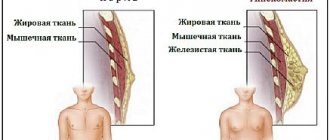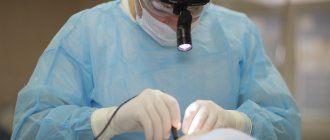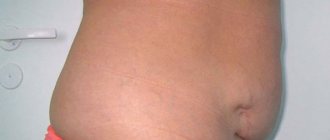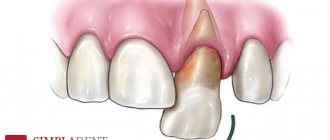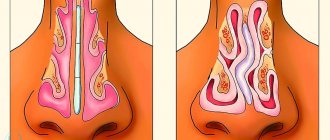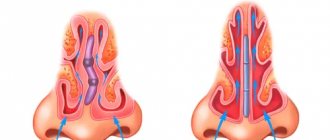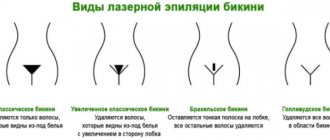Consultation with plastic surgeons with over 20 years of experience – free! Sign up by phone. Waiting for you! Beautiful breasts are an indispensable attribute of the female body, but sometimes enlarged mammary glands are inappropriately present in the male half of humanity.
Gynecomastia is a benign enlargement of the mammary gland that can occur in both teenage boys and men of all ages.
If a man has symptoms of gynecomastia, plastic surgery is performed.
If there are signs of gynecomastia, consultation with an endocrinologist and extensive hormonal examination is necessary.
Causes
Note that pathology can be of two types:
- True. The enlargement of the mammary glands is caused by the proliferation of the glandular tissue of the glands themselves.
- False. In this case, the breasts increase in volume due to adipose tissue. The most common cause of the disease is obesity.
In most cases, the development of true gynecomastia is associated with hormonal disorders. As a rule, a man with this disease has an increased level of estrogen (the main female hormone), and the level of testosterone, on the contrary, decreases.
In addition, the following factors can cause pathology:
- The presence of pituitary tumors, in which prolactin levels increase. In men, this leads to breast growth.
- A metabolic disorder in which the organs responsible for the production of important hormones fail.
- Taking certain medications, in which breast enlargement is one of the side effects.
- Excessive consumption of beer, which contains phytoestrogens.
- Injuries to the scrotum, orchiitis, STDs or other “male” diseases that can reduce the production of male hormones.
Materials
DEKA MELA
The DEKA company is a global manufacturer of high-tech laser medical equipment for...
Laser lipolysis on the basis of the DEKA laser technology clinic for the period from 2015 to 2022 was performed 54 times using the Italian DEKA SmartLipo device with a wavelength of 1064 nm pulsed Nd:YAG, one-stage, after total removal of the mammary glands in case of true gynecomastia through the periareolar approach (along the lower pole, through an oval incision of 2.5–3.0 cm). The average age of the men was 30 years.
Indications and contraindications for surgery
It is not difficult to recognize the presence of gynecomastia in men. The main symptom is an increase in the volume of the mammary glands (can be observed only on the left, only on the right, or on both sides), which can reach 10-15 cm in diameter. At the same time, the nipples also enlarge, the parapapillary areas (alveoli) expand, which become darker, similar to those of women.
If you suspect gynecomastia, you must consult a doctor and identify the exact cause of the development of the pathological process.
In what cases may surgery be required?
- Neoplasm in the area of the mammary glands.
- Lumps, cysts in the breast, discharge from the nipples.
- Lack of effect from conservative therapy.
- A man’s painful perception of his body, strong emotional discomfort.
The decision on the advisability of surgical intervention is made solely by the doctor. It is worth noting that gynecomastia cannot be performed in all cases. Contraindications include the following factors:
- Heart failure.
- Inflammatory or infectious processes in the acute stage.
- Blood diseases, bleeding disorders.
- Excess weight (obesity 2-3 degrees).
Gynecomastia is not performed during adolescence. This period is characterized by hormonal surges, and therefore gynecomastia is a variant of the norm. As a rule, after puberty ends, the problem resolves itself.
Removal of gynecomastia in men
The main questions that the patient poses to the surgeon:
How to get rid of gynecomastia?
What is gynecomastia?
This is a benign enlargement of the mammary (or mammary) glands in men. As a rule, a distinction is made between true gynecomastia and false, or pseudogynecomastia.
True gynecomastia is caused by the proliferation of glandular tissue of the mammary gland. Such gynecomastia, like mastopathy, can be in diffuse and nodular form. Gynecomastia may be accompanied by painful sensations and discharge from the nipple (clear, cloudy, bloody, colostrum). The mammary glands enlarge, become dense, and sometimes painful.
If it is false, the increase in the volume of the mammary gland is associated with fat deposits. Moreover, in some cases, obesity can be combined with true gynecomastia.
What are the reasons for the changes?
Gynecomastia in men occurs in many diseases, but most often, enlargement of the mammary glands in men is associated with an imbalance of male and female sex hormones (testosterone/estrogens) and a hereditary constitutional feature. In adolescents, it develops as a result of various hormonal disorders, and during puberty, such a nuisance occurs in every third young man. But when the hormonal crisis passes, the process usually stops on its own. However, breast growth can also be a consequence of hormonal disorders caused by inflammation of the testicles, insufficient production of testosterone, which can be observed with bruises of the testicles, some diseases of these organs, receiving large doses of radiation, diseases of the thyroid gland and adrenal glands. This type of gynecomastia can begin at any age. Bodybuilders taking anabolic steroids, patients taking psychotropic drugs and veroshpiron, anti-tuberculosis drugs for a long time are at serious risk.
False (fatty) gynecomastia is a condition in which the mammary glands of the stronger sex of any age grow due to the proliferation of adipose tissue. This type of disease is always combined with increased body weight.
What are the dangers of changes, besides a cosmetic defect?
True gynecomastia is not only a cosmetic defect, but can also pose a serious health hazard, including malignant degeneration. If you notice the following symptoms of breast cancer, you should pay close attention and consult a doctor: the appearance of dense formations in the mammary gland, changes in the skin over the formation, bloody discharge from the nipple, the appearance of small ulcers, enlarged axillary lymph nodes.
What are the indications for surgery?
Attempts to cope with gynecomastia on your own are doomed to failure. Massage does not affect glandular and adipose tissue. There is no point in bandaging, or working out in the gym - enlarged pectoral muscles push the gland even further forward.
Conservative treatment of gynecomastia to reduce the volume of the mammary glands is carried out by an endocrinologist in case of imbalance of testosterone/estrogens on an outpatient basis. Prescription of hormonal therapy leads to reduction of mammary glands.
Are there any contraindications for performing the operation?
The following contraindications exist:
- Blood clotting disorder.
- Uncompensated diabetes mellitus.
- Some thyroid diseases.
- Hypertension in the stage of decompensation.
What preparation is required before surgery?
During the preparatory period for surgery, the patient should stop smoking, not drink alcohol, eat properly (meat, fruits, vegetables, dairy products), and in no case take medications without the doctor’s knowledge, even aspirin, which affects blood clotting .
Before surgery for gynecomastia, a man must definitely visit an endocrinologist. In addition, an analysis of the level of certain hormones in the blood is required.
Before the operation, an ultrasound scan of the mammary glands and axillary lymph nodes is prescribed.
You must not eat or drink 4 hours before surgery; you must shower before surgery.
How is the operation selected?
The choice of surgery depends on the form of gynecomastia. In true gynecomastia, the tumor is removed through a surgical incision. Treatment of nodular forms of gynecomastia is necessarily surgical, because the nodular form of gynecomastia is a potential precancer.
For false (fatty) gynecomastia, laser liposuction is performed. Liposuction is considered a cosmetic surgery, since this disease does not pose a threat to the patient's health.
Surgery to eliminate gynecomastia is usually performed under general anesthesia and lasts 30-60 minutes.
How is the operation performed?
In case of true gynecomastia, after anesthesia and treatment of the skin with an antiseptic solution, a semi-oval skin incision is made along the edge of the areola. Then the formation and breast tissue are removed. The removed tissue is necessarily sent for histological examination. A cosmetic skin suture is performed, leaving drainage for 1-2 days. A pressure bandage is applied.
Modern surgery allows the use of endoscopic treatment of gynecomastia, replacing complex traumatic open operations. This allows you to achieve the greatest cosmetic effect due to the fact that a small incision is made in the armpit area, the dimensions of which can be only about 3 cm. A special optical instrument is inserted through this incision, which lifts the skin tissue. The surgeon performs the entire operation guided by a magnified image on the monitor screen. After this, the glandular tissue is removed using small endoscopic instruments. The operation itself is performed at a considerable distance from the incision site. Considering the fact that the incision is made in the armpit, in the area of the hair growth area, the small postoperative scar is practically invisible.
The use of endoscopic approaches for plastic surgery avoids the need for large skin incisions, leads to a reduction in surgical blood loss, a reduction in the length of hospital stay of patients and, as a result, determines the pronounced economic effect expected from the clinical use of these techniques.
Laser liposuction is a method that is used to remove excess fat tissue in cases of false gynecomastia. In this case, after anesthesia, a thin laser is introduced under the skin through a 2-3 mm puncture, which destroys fat cells, turning them into a homogeneous mass. Immediately after the laser operates, the specified mass is removed from the body through a special thin tube connected to a vacuum device. There are practically no scars left after the operation.
How is the postoperative period going?
After surgery to remove gynecomastia, you may experience pain for some time. Regular painkillers are effective. The operation is performed in the morning, and the patient is discharged from the hospital in the evening.
In the future, the areas that have undergone surgical intervention will be swollen and firm when palpated. Pain occurs only with certain types of movements, especially with sudden movements of the hands.
Sutures are removed 10 days after surgery. It is necessary to wear special compression garments for 14 days that fit tightly and tighten the operated areas to prevent bleeding, swelling and swelling in the early postoperative period.
What rehabilitation products and medications are taken after surgery?
Immediately after the operation, we recommend performing a complex of physiotherapeutic treatment: Ultrasound with hydrocortisone, microcurrent therapy, magnetic laser therapy. The day after surgery, it is recommended to use the wound healing agent Cellgel on the sutures for better healing and the formation of an inconspicuous scar. After the crusts on the seams come off, to quickly transform the scars into invisible ones, we recommend Dermatix silicone gel for 2 months.
Are there any side effects or complications after surgery?
The following side effects may occur: compactions in the area of surgical intervention, painful when palpated.
Complications that may occur after surgery for true gynecomastia: bleeding, hematoma, seroma, blackening of the areola complex. After surgery for false gynecomastia: skin burns, excess skin sagging, repeat surgery may be required (rarely).
What restrictions and recommendations exist after surgery?
For 2 months after the operation, bathhouses, saunas, and solariums are prohibited. You can return to normal physical activity after a month.
Gynecomastia is an enlargement of the mammary glands in men, which occurs as a result of any disease (true gynecomastia) or constitutional features (false gynecomastia). How to get rid of gynecomastia? To treat this disease, removal of the formation through an incision or endoscopic surgery with a hidden incision, or laser liposuction is used to remove excess fat in this area. Often these operations are performed simultaneously.
Preparation rules
If the doctor decides that surgery is necessary, the patient will have to undergo careful preparation. First of all, you need to undergo an examination, which includes:
- General blood and urine analysis.
- Blood test for clotting.
- Blood test for HIV, hepatitis and syphilis.
- Study of the hormonal spectrum of blood (testosterone, prolactin, estrogen, FSH).
- Fluorography.
- Electrocardiogram.
- Ultrasound examination of the mammary glands.
- A certificate from a physician stating that there are no contraindications to surgery.
This is the minimum list of necessary preparatory procedures. If necessary, the doctor may prescribe other types of diagnostics.
It is also worth checking out the list of recommendations:
- Surgery is performed on an empty stomach, which means that the patient must abstain from food for at least 7-8 hours before surgery.
- 3 hours before the appointed time you need to refuse water.
- A few days before the procedure, it is recommended to include more fresh vegetables, fruits, dairy products, etc. in your diet.
- Be sure to remove excess hair in the chest area.
- If you are worried about the feeling of fear before surgery, consult your doctor about taking sedatives.
How do you know for sure if you have gynecomastia?
For an accurate diagnosis, it is necessary to conduct a range of instrumental and laboratory studies. However, sometimes it is not possible to identify significant deviations from the norm, in which case gynecomastia is defined as idiopathic. It occurs in about half of the cases.
Minimum examinations:
- determination of hormone concentrations;
- liver and kidney function tests;
- ultrasound examination of the gland;
- mammography.
What hormones need to be tested for male gynecomastia?
- FSH;
- testosterone;
- estradiol;
- LG.
Additionally, it may be necessary to determine the concentration of prolactin, CVS, hCG, and α-fetoprotein. If necessary, an ultrasound of the testicles is prescribed (to exclude hormone-producing tumor processes). In doubtful cases, the doctor performs a biopsy - a puncture of epithelial cells - the result of which will show whether there is cancer in the glands.
How is the operation performed?
Most often, the operation is performed under general anesthesia. However, the issue of anesthesia is decided individually with each patient.
Depending on the type of gynecomastia and the individual characteristics of the body, surgical intervention can be performed in various ways:
- Mastectomy – removal of gland tissue using an endoscope.
- Liposuction is the removal of excess fat in the breast area through an aspirator.
- Combined – mastectomy with liposuction.
With the endoscopic method of surgery, a tiny incision is made in the armpit through which the necessary instruments are inserted, including a miniature camera with which you can monitor the operation on a monitor.
Unnecessary tissue is excised (including excess skin). And at the end of the surgical intervention, the doctor applies stitches and elastic bandages. It is worth noting that the nipple and the surrounding areola are necessarily preserved. The duration of the operation is about one and a half hours.
If everything went without complications, the patient can go home after 3-4 days.
Prices
If gynecomastia is diagnosed, how much does surgery cost? The price of surgery for gynecomastia in men depends on the type of intervention (mastectomy or liposuction). The cost of treatment for gynecomastia in Moscow is also affected by the volume of surgical intervention. Our clinic offers patients various treatment methods. The clinic’s clients are also given the opportunity to undergo treatment in installments, having previously obtained a loan.
| Type of service | Service cost |
| Surgical correction of gynecomastia (in men) category 1 | 90,000 rub. |
| Surgical correction of gynecomastia (in men) category 2 | 100,000 rub. |
Show all price
Rehabilitation period
To reduce the risk of complications after surgery, it is recommended to follow some rules:
- Follow your doctor's orders. The doctor may prescribe a course of antibacterial or anti-inflammatory drugs. And to reduce the intensity of postoperative pain - painkillers.
- Until complete recovery, it is recommended to avoid increased physical activity.
- You must constantly wear compression garments; the degree of compression is determined individually.
- It is necessary to avoid going to the bathhouse, sauna and swimming pool until complete recovery.
In just 5-7 days you can return to your normal rhythm of life, and after a month you can play sports again and enjoy your new body. The final result can be assessed after 3 months.
You can find out more detailed information about surgery for gynecomastia during an in-person consultation with a specialist. Be healthy!
Rehabilitation
During the first few hours after the intervention, wound fluid flows through drains installed during surgery. During this period, we provide the patient with rest and medical supervision. Since after surgery performed on men who took anabolic steroids and professional athletes there is a high risk of bleeding in the postoperative period, they are under the supervision of our surgeons for several days.
We recommend that patients wear compression stockings for six weeks. This is necessary to consolidate the results of the operation and speed up the recovery process. Doctors at our clinic do not advise operated patients to undergo physical activity, lift weights, exercise, contact sports, visit a sauna or bathhouse, or take a hot bath during the first month.
Operating principle
Treatment with the Lumenis M22 device is the safest and most effective method for removing any vascular formations. During the procedure, the light flux acts specifically on the skin without affecting healthy cells. Only blood vessels and spider veins are exposed to heat - they are “sealed” under the influence of a light wave and then gradually dissolve, and pathological vessels and redness disappear from the skin without a trace. As a result, it is possible to restore a natural, even and healthy skin tone.
results
In all clinical cases, follow-up was performed 1 – 3 – 6 months after surgery. All surgical interventions were performed by us according to indications, with a confirmed diagnosis with an ultrasound report. With total removal of the mammary glands, no relapses were detected. By combining the surgical technique of removing the mammary glands with laser lipolysis using the DEKA SmartLipo device with a wavelength of 1064 nm pulsed Nd:YAG, we obtained the most harmonious aesthetic appearance of the anterior chest. The laser lipolysis method using a coagulation cannula allows you to bloodlessly, over a wide area, isolate a sufficient amount of subcutaneous fat to replace the defect in the area of the removed mammary gland to achieve a good aesthetic result and smooth contours in the anterior chest area. The optical fiber of a helium-neon laser with a beam flux of 1 mW, 632.8 nm destroys the membranes of fat cells and inhibits the life cycle of the remaining ones, which has a beneficial effect in the long-term postoperative period on the aesthetic appearance of the anterior chest.
Thanks to laser lipolysis using the DEKA SmartLipo device, the postoperative rehabilitation period is reduced to 10 days on average.
Advantages of the technique
- Safety. During phototherapy, the effect is only on hemoglobin in damaged vessels, while healthy surrounding tissue is not affected. The technique has a minimum of contraindications and side effects and is suitable for removing vascular pathologies of any size.
- Efficiency. The method ensures complete removal of visible blood vessels and improvement of skin quality. Additionally, the effect of photorejuvenation is achieved.
- Painless. The equipment is equipped with a special cooling system, which increases the comfort of the procedure and prevents any unpleasant symptoms during the session.
Prices for removal of vascular pathologies using the M22 device
| REMOVAL OF VASCULAR PATHOLOGIES (M22) |
| Service code | Service name | Number of services | Price |
| A20.01.005.011 | Skin phototherapy (Removal of vessels on the wings of the nose M22) Code: A20.01.005.011 | 1 | 3 500 ₽ |
| A20.01.005.016 | Skin phototherapy (Removal of blood vessels on the face 1 impulse 1cm2 M22) Code: A20.01.005.016 | 1 | 500 ₽ |
| A20.01.005.012 | Skin phototherapy (removal of vessels on the nose M22) Code: A20.01.005.012 | 1 | 4 500 ₽ |
| A20.01.005.013 | Skin phototherapy (Removal of blood vessels on the chin M22) Code: A20.01.005.013 | 1 | 4 000 ₽ |
| A20.01.005.014 | Phototherapy of the skin (Removal of blood vessels on the cheekbones M22) Code: A20.01.005.014 | 1 | 4 500 ₽ |
| A20.01.005.017 | Skin phototherapy (Removal of blood vessels on the body 1 impulse 1cm2 M22) Code: A20.01.005.017 | 1 | 300 ₽ |
| A20.01.005.015 | Phototherapy of the skin (Removal of blood vessels on the cheeks M22) Code: A20.01.005.015 | 1 | 5 000 ₽ |
Clinical examples
The effectiveness of surgical intervention was assessed by objective methods: maintaining a photo protocol, local measurements and markings. The state of skin turgor, subcutaneous fat and the presence of fibrosis formation were assessed by subjective research methods - digital (pinch test). Measurements were taken before surgery, 1 and 3 months after surgery.
Patient 1
Complaints: enlarged mammary glands on both sides and unsatisfactory shape of the areola on the right. He noticed enlargement of the mammary glands at the age of 16. Age – 28 years.
Conclusion Ultrasound of the mammary glands: enlargement of the mammary glands on both sides.
Performed: bilateral mastectomy with laser lipolysis.
Figure 2. (a)
Photos before mastectomy with laser lipolysis.
Figure 2. (b)
Photos 7 days after surgery.
Figure 3. (a)
Right removed mammary gland, diameter 10.0 cm.
Figure 3. (b)
Left removed mammary gland, diameter 9.0 cm.
Patient 2
Complaints: enlarged mammary glands and unsatisfactory shape of the areolas on both sides. Enlargement of the mammary glands was noted 2 years after taking steroid drugs while working out in the fitness room. Age – 24 years.
Conclusion Ultrasound of the mammary glands: enlargement of the mammary glands on both sides.
Performed: bilateral mastectomy with laser lipolysis.
Figure 4. (a)
Photos before mastectomy with laser lipolysis.
Figure 4. (b)
Photos 1 month after surgery.
Figure 5. (a)
The right removed mammary gland with small three lobules, diameter 8.0 cm.
Figure 5. (b)
Left removed mammary gland with three lobules, diameter 7.0 cm.
